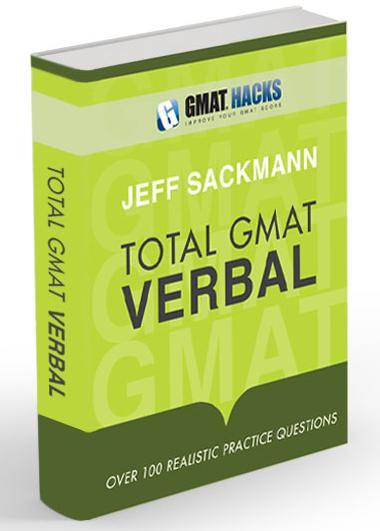
Bookshelf
|
|
Total GMAT Math Jeff's complete Quant guide, on sale now! |
|
|
Total GMAT Verbal Everything you need to ace GMAT Verbal! |
1,800 Practice Math Questions
Buy Jeff's books at Amazon.com

GMAT Official Guide, with IR
OG Math | OG Verbal
OG12 & Quant Rev solutions!
GMAT Question of the Day
Beginner's Guide to the GMAT
GMAT Hacks Affiliate Program

Recent Hacks

Categories
- General Study Tips
- Goals and Planning
- CAT Strategy
- The Mental Game
- GMAT Math Strategy
- GMAT Math Topics
- Mental Math
- Data Sufficiency
- Critical Reasoning
- Reading Comprehension
- Sentence Correction
- Analytical Writing Assessment
- Integrated Reasoning
- IR Explained
- Business School Admissions
- GMAT Prep Resources
- Practice Questions
- Total GMAT Math
- Total GMAT Verbal
- GMAT 111

Feeling Good During the GMAT
| You should follow me on Twitter. While you're at it, take a moment to subscribe to GMAT Hacks via RSS or Email. |
One thing that makes the Computer-Adaptive Test such a unique experience is that it is so tempting to try to interpret how well you're doing on the exam. Since you know the test is adaptive, you might see a very difficult question and take it as a sign that you're doing well, or see an easy question and take it as a sign that you're doing horribly.
I can't emphasize it enough: Don't think about that stuff when you're taking the test. There are too many variables that you can't be aware of, including experimental questions and your own unique strengths and weaknesses, which might make a "hard" question reasonably easy for you, or vice versa.
One particularly dangerous version of this phenomenon arises when you adapt your test-taking behavior to how you feel during the test. For instance, if you feel like you handle a few questions easily, you may start to feel more confident in your GMAT skills and become a little less careful.
Too Much Confidence is Dangerous
Because the GMAT is adaptive, you're probably going to get lots of questions wrong. As I've written again and again, only the very best test-takers get anywhere close to 100% of questions right. Even if you score in the 80th percentile range (remember, two 80th percentile scores gets you a 700 overall), you're probably getting 10 questions wrong per section. That's ok--it's just how the test works.
Remember, also, that most of the content of the GMAT will be familiar. There's only so much math that the GMAT tests, so you're unlikely to get a barrage of questions that blow you away with difficulty. What makes questions tricky are subtleties, especially in Data Sufficiency. If you miss the subtleties, you probably miss the questions...but you probably don't know it.
In other words, you aren't the best judge of how many questions you're getting right. If you're feeling good, thinking you've gotten the last 5 or 6 questions right, you probably missed one or two along the way. If you get 5 or 6 consecutive questions right on the GMAT, you're going to see some really, really hard stuff.
So here's the problem. If you think you're getting a bunch of questions right, you start feeling confident, despite the fact that you've probably missed a few subtle twists that caused you to get a couple of those questions wrong. Your confidence may well make you even less likely to recognize similar subtleties on future questions. It's a dangerous cycle. As a result, you can feel great throughout an entire section but score horribly.
Stop Thinking About It!
There's only one solution to this problem, and it's not an easy one to implement. You simply must take every question on its own, thinking about it as thoroughly as possible within the proper time frame. You don't know what's going on with the CAT algorithm, so all you can do is get as many questions right as possible.
The more you're thinking about the algorithm and how you've performed up to a certain point, the less you are focused on the question at hand. The GMAT provides enough challenges that you don't need to bring in some of your own!
The test should be hard. You should get quite a few questions wrong. For many people, the difference between a good day and a bad day could be 12 questions wrong instead of 15 questions wrong. You won't be able to recognize that difference while you're sitting at the terminal. Focus on the questions, read carefully, and let yourself answer each question to the best of your ability.
About the author: Jeff Sackmann has written many GMAT preparation books, including the popular Total GMAT Math, Total GMAT Verbal, and GMAT 111. He has also created explanations for problems in The Official Guide, as well as 1,800 practice GMAT math questions.
 |
Total GMAT Verbal
The comprehensive guide to the GMAT Verbal section. Recognize, dissect, and master every question type
you'll face on the test. Everything you need, all in one place, including 100+ realistic practice questions. |